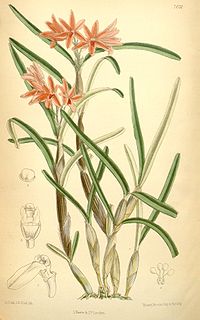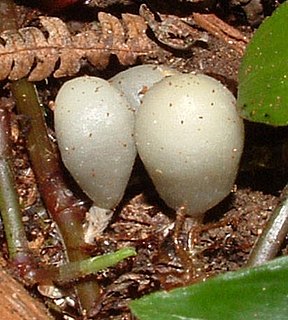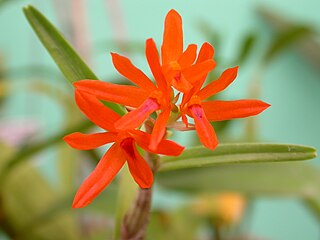Genus is a taxonomic rank used in the biological classification of living and fossil organisms as well as viruses, in biology. In the hierarchy of biological classification, genus comes above species and below family. In binomial nomenclature, the genus name forms the first part of the binomial species name for each species within the genus.

Manilkara is a genus of trees in the family Sapotaceae. They are widespread in tropical and semitropical locations, in Africa, Madagascar, Asia, Australia, and Latin America, as well as various islands in the Pacific and in the Caribbean. A close relative is the genus Pouteria.

A botanical name is a formal scientific name conforming to the International Code of Nomenclature for algae, fungi, and plants (ICN) and, if it concerns a plant cultigen, the additional cultivar or Group epithets must conform to the International Code of Nomenclature for Cultivated Plants (ICNCP). The code of nomenclature covers "all organisms traditionally treated as algae, fungi, or plants, whether fossil or non-fossil, including blue-green algae (Cyanobacteria), chytrids, oomycetes, slime moulds and photosynthetic protists with their taxonomically related non-photosynthetic groups ."

Epidendrum, abbreviated Epi in the horticultural trade, is a large neotropical genus of the orchid family. With more than 1,500 species, some authors describe it as a mega-genus. The genus name refers to its epiphytic growth habit.
Hamadryas was a nymph, the mother of the hamadryads in Greek mythology, and the name has been used repeatedly in scientific naming and may refer to:
A tautonym is a scientific name of a species in which both parts of the name have the same spelling, for example, Rattus rattus. The first part of the name is the name of the genus and the second part is referred to as the specific epithet in the International Code of Nomenclature for algae, fungi, and plants and the specific name in the International Code of Zoological Nomenclature.
In zoological nomenclature, the specific name is the second part within the scientific name of a species. The first part of the name of a species is the name of the genus or the generic name. The rules and regulations governing the giving of a new species name are explained in the article species description.

Hexisea is a genus of orchids. The genera CostaricaeaSchltr. and EuothonaeaRchb.f. are synonyms of Hexisea. This genus is abbreviated Hxsa in trade journals.

Laeliinae is a Neotropical subtribe including 40 orchid genera, such as Brassavola, Laelia and Cattleya. The genus Epidendrum is the largest within this subtribe, containing about 1500 species. This is followed by the genus Encyclia, with over 120 species.
In botanical nomenclature, autonyms are automatically created names, as regulated by the International Code of Nomenclature for algae, fungi, and plants that are created for certain subdivisions of genera and species, those that include the type of the genus or species. An autonym might not be mentioned in the publication that creates it as a side-effect. Autonyms "repeat unaltered" the genus name or species epithet of the taxon being subdivided, and no other name for that same subdivision is validly published. For example, Rubus subgenus Eubatus is not validly published, and the subgenus is known as Rubus subgen. Rubus.
Leslie Pedley was an Australian botanist who specialised in the genus Acacia. He is notable for bringing into use the generic name Racosperma, creating a split in the genus with some 900 Australian species requiring to be renamed, since the type species of Acacia, Acacia nilotica, now Vachellia nilotica, had a different lineage from the Australian wattles. However, the International Botanical Congress (IBC) in Melbourne in 2011 ratified their earlier decision to retain the name Acacia for the Australian species and to rename the African species.

Priority is a fundamental principle of modern botanical nomenclature and zoological nomenclature. Essentially, it is the principle of recognising the first valid application of a name to a plant or animal. There are two aspects to this:
- The first formal scientific name given to a plant or animal taxon shall be the name that is to be used, called the valid name in zoology and correct name in botany.
- Once a name has been used, no subsequent publication of that name for another taxon shall be valid (zoology) or validly published (botany).

Rhynchotherium is an extinct genus of proboscidea endemic to North America and Central America during the Miocene through Pliocene from 13.650—3.6 Ma, living for approximately 10 million years .

Psilocybe weraroa, is a hallucinogenic pouch fungus of New Zealand.

Eoconfuciusornis a genus of extinct avialan that lived 131 Ma ago, in the Early Cretaceous of China.

Scaphyglottis is a genus of orchids native to Mexico, Central America, northern South America and parts of the Caribbean. The current concept of this genus is the result of combining several genera which have been described at various times. The concept is characterized by the growth habit: not only are new pseudobulbs added at the base of the old ones, but new pseudobulbs also grow at the apices of the old ones. Many species are quite similar and difficult to distinguish, but some are clearly distinct. A few have showy colors. The genus comprises nearly 70 species.
Nomen illegitimum is a technical term, used mainly in botany. It is usually abbreviated as nom. illeg. Although the International Code of Nomenclature for algae, fungi, and plants uses Latin terms for other kinds of name, the glossary defines the English phrase "illegitimate name" rather than the Latin equivalent. However, the Latin abbreviation is widely used by botanists and mycologists.
H. bidentata may refer to:
S. bidentata may refer to:
Cherwellia is an extinct genus of mammaliaforms, possibly belonging to Morganucodonta, that lived in what is now England during the Middle Jurassic. The type and only known species is Cherwellia leei. It was first described in 2016 by Percy M. Butler and Denise Sigogneau-Russell from a single lower molar found at the Kirtlington Quarry of the Forest Marble Formation.










